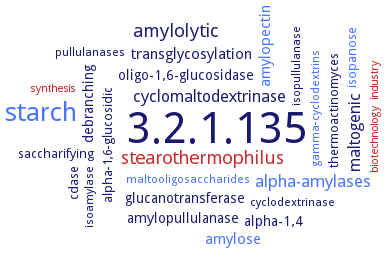3.2.1.135: neopullulanase
This is an abbreviated version!
For detailed information about neopullulanase, go to the full flat file.

Word Map on EC 3.2.1.135 
-
3.2.1.135
-
starch
-
stearothermophilus
-
amylolytic
-
alpha-amylases
-
cyclomaltodextrinase
-
maltogenic
-
amylopectin
-
transglycosylation
-
amylose
-
alpha-1,4
-
amylopullulanase
-
debranching
-
oligo-1,6-glucosidase
-
glucanotransferase
-
thermoactinomyces
-
alpha-1,6-glucosidic
-
isopanose
-
cdase
-
saccharifying
-
pullulanases
-
cyclodextrinase
-
maltooligosaccharides
-
isoamylase
-
isopullulanase
-
gamma-cyclodextrins
-
biotechnology
-
industry
-
synthesis
- 3.2.1.135
- starch
- stearothermophilus
-
amylolytic
- alpha-amylases
- cyclomaltodextrinase
-
maltogenic
- amylopectin
-
transglycosylation
- amylose
-
alpha-1,4
- amylopullulanase
-
debranching
- oligo-1,6-glucosidase
-
glucanotransferase
-
thermoactinomyces
-
alpha-1,6-glucosidic
- isopanose
-
cdase
-
saccharifying
- pullulanases
- cyclodextrinase
- maltooligosaccharides
- isoamylase
- isopullulanase
- gamma-cyclodextrins
- biotechnology
- industry
- synthesis
Reaction
Synonyms
Amo105, amylopullalanase, amylopullulanase, ApuA, ApuADELTA, bsNpl, cyclomaltodextrinase, Env Npu193A, More, neopullulanase-alpha-amylase, neopullulanase-like enzyme, Pul, pullulan 4-D-glucanohydrolase (6-alpha-D-glucosylmaltose), pullulan hydrolase type I, pullulanase, pullulanase II, pullulanase, neo-, Rbamy5, TetApuM955, TetApuR855, type II pullulanase, type III pullulan hydrolase
ECTree
Advanced search results
General Information
General Information on EC 3.2.1.135 - neopullulanase
Please wait a moment until all data is loaded. This message will disappear when all data is loaded.
evolution
analysis and verification of neopullulanases belonging to the alpha-amylase family GH13, subfamily GH13_20, but also subfamily GH13_36, an intermediary group, which is defined using the sequence of the fifth conserved sequence region (CSR) as a selection marker. Evolutionary relationships and tree, and conserved sequence regions of GH13 subfamilies, detailed overview. The GH13_20 neopullulanase from Bacillus stearothermophilus in complex with maltotetraose is a representative of the neopullulanase subfamily. One of the most clear sequence signatures of true members of the neopullulanase subfamily subfamily GH13_20 is the stretch VANE succeeding the catalytic nucleophile in the CSR II, although not every GH13_20 member has to possess this segment in its entirety. GH13_36 enzymes contain a histidine at the end of the CSR II (strand beta4) and a tryptophan (or at least an aromatic residue) two residues succeeding the catalytic proton donor in the CSR III (strand beta5)
physiological function
-
the enzyme may have a role to provide branched maltooligosaccharides to stimulate the growth of beneficial microorganisms in the human intestine
physiological function
-
the enzyme may have a role to provide branched maltooligosaccharides to stimulate the growth of beneficial microorganisms in the human intestine
-


 results (
results ( results (
results ( top
top






